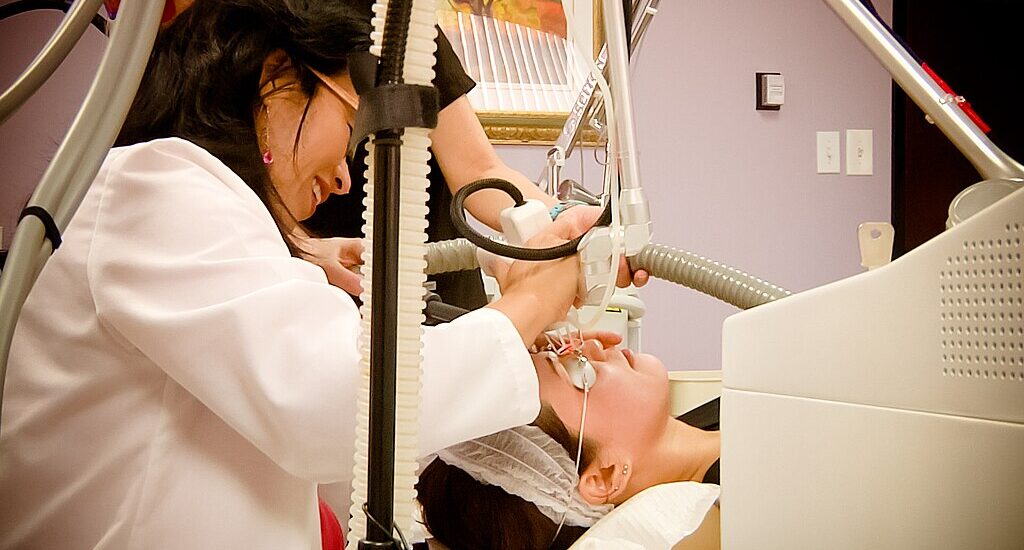Our aim with this comprehensive guide is to shed light on the care protocols and solutions to problems that affect the skin after fractional laser treatment.

Table of Contents
Delving into the Fractional Laser Procedure
Fractional laser treatments involve the use of laser beams to create micro-injuries in the skin’s deeper layers, encouraging the natural healing process and stimulating collagen production. These microscopic zones are precisely targeted, leaving the surrounding skin untouched.
Studies have showcased the effectiveness of fractional lasers in reducing fine lines, sun damage, and other skin imperfections, making them a popular choice for skin rejuvenation.
Caring for Your Skin After Fractional Laser Treatment
Ensuring proper care for your skin after fractional laser treatment is not only pivotal for achieving the best results from your fractional laser treatment but also for preventing complications. Let’s delve into the essentials of post-procedural care to help guide you through the recovery period:
Keep it Clean
Cleaning the treated area aids in preventing infections and aids in the healing process. Opt for a gentle, hydrating cleanser free from alcohol and harsh chemicals, which might irritate the sensitive post-treatment skin. You can confirm with your dermatologist if the Cetaphil Face Wash, Hydrating Gentle Skin Cleanser on Amazon is suitable for your skin.
Cleanse the area twice daily using lukewarm water and pat dry gently with a soft cloth. Avoid rubbing the skin, as this can cause irritation.
Dr. Cory Tergeson emphasizes the significance of cleanliness to prevent complications.
Stay Hydrated
Your skin after fractional laser treatment can often feel tight and dry. Using a hypoallergenic, fragrance-free moisturizer can help maintain the skin’s moisture barrier and reduce discomfort. You can check out the Cetaphil Body Moisturizer on Amazon.
Moisturize frequently throughout the day, and remember that hydration isn’t just topical; drinking adequate water helps the skin from the inside out, promoting faster recovery.
Avoid Sun Exposure
The skin becomes exceptionally sensitive to sunlight post-treatment. Direct sun exposure can exacerbate redness, cause sunburn, or lead to hyperpigmentation. To protect the treated skin, limit direct sun exposure, especially between 10 a.m. and 4 p.m. when the sun’s rays are the strongest.
Applying a broad-spectrum sunscreen of SPF 30 or higher is essential, even on overcast days. Consider reapplying sunscreen every 2 hours or more frequently if sweating or swimming. Try out this Amazon-listed Neutrogena Ultra Sheer Dry-Touch Water Resistant and Non-Greasy Sunscreen.
Common Problems and Solutions
The skin after fractional laser treatment undergoes a healing phase where certain reactions are typical. Being aware of these responses and knowing how to manage them can pave the way for a smoother recovery:
Redness and Swelling
A typical immediate reaction of the skin after fractional laser treatment is the appearance of redness and swelling, often likened to a sunburn. The intensity varies depending on the individual and the treatment’s depth. While it generally subsides within a few days to a week, managing it involves:
Using over-the-counter anti-inflammatory medications like ibuprofen (unless contraindicated).
Applying cold compresses in intervals. This means 20 minutes on and then 20 minutes off to prevent frostbite.
Keeping the head elevated during sleep can reduce swelling, especially on the face.
If redness and swelling persist beyond a week, seek guidance from your dermatologist.
Peeling or Crusting
As the skin starts to heal, it’s natural to experience some flaking or crusting. This is a sign of the old skin making way for the new rejuvenated layer underneath. Essential points to remember are:
Do not pick, scratch, or peel off the crusts. Doing so can introduce infections and might result in scarring.
Keep the skin moisturized to alleviate the dryness and reduce the peeling.
If crusting is excessive, reach out to your healthcare provider. They may recommend specific emollients or ointments to aid the process.
Hyperpigmentation
Hyperpigmentation, or the darkening of the treated skin areas, can sometimes occur post-laser, especially in individuals with darker skin types or those who get sun exposure during the recovery phase. To manage and prevent this:
Avoid sun exposure and religiously apply broad-spectrum sunscreen.
Over-the-counter lightening agents containing ingredients like vitamin C, niacinamide, or licorice root extract can be beneficial. Always patch-test before applying on the treated area.
For persistent hyperpigmentation, consult your dermatologist. They might prescribe stronger lightening agents or other treatments to address the concern.
Skin After Fractional Laser [Other Issues]
Below are links to articles on this site that address other fractional laser issues that you might encounter not fully covered in this article.
How Long Does It Take to See Results from Fractional Laser?
How to Take Care of Skin After Fractional Laser: Easy Guide
Does Fractional Laser Tighten Skin? Comprehensive Answer
What to Avoid After Fractional Laser: Comprehensive Guide
How Long Does It Take to Heal from Fractional Laser?
What to Do After Fractional Laser: A Step-by-Step Guide
Rough Skin After Fractional Laser: Causes & Management
Dry Skin After Fractional Laser: Causes, Care, & Solutions
How to Remove Dead Skin After Fractional Laser: 7 Easy Steps
How to Treat Skin After Fractional Laser: Complete 411 Guide
Skin Peeling After Fractional Laser: Comprehensive 411 Guide

